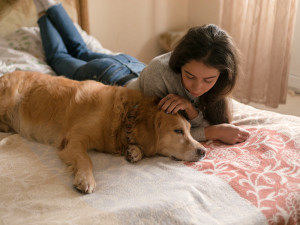What Do You Tell Your Kids When Your Family Pet Dies?
Fluffy didn’t go to a farm to chase rabbits, so maybe don’t say she did.
For a lot of children, their first experience with death is the loss of a beloved family pet. Although they may be familiar with the idea of death from movies, TV, and their friends at school, the reality of death is often quite different and its impact on them can be profound, especially if it isn’t handled properly.
“As parents, we have a natural desire to protect our kids from heartbreak, loss, and tears,” says grief counselor Leigh Ann Gerk, owner and founder of Mourning to Light Pet Lossopens in new tab and author of the Indie award-winning children’s bookopens in new tab on pet loss and grief, Dear Brave Friend. “But you can’t really protect them from death. Somewhere in their life, the child will encounter it.” Better that they do when you are there to help them.
How should you talk to your kids when their pets die?
1. Be honest.
“It is important to tell your children the truth,” Gerk says. “Do it in a way that is age-appropriate and non-horrific, but do it. If a child has to guess why their pet is gone, they will often imagine something that is much bigger, scarier, and more distressing than the truth. For instance, if a parent tells their child that ‘Fluffy’ ran away instead of saying that she died, that child might worry about Fluffy, wondering if [she is] cold, hungry, in danger, etc.”
It’s also important to remember that although a lie might seem like the easiest, safest thing to do in the moment, your child will learn the truth eventually. And when they do, it could change the way they see you and make it harder for them to trust you.
How much do you spend on your pet per year?
2. Answer their questions.
“Even the difficult ones,” Gerk says. “Answer them simply and honestly, using words and concepts the child will understand.”
3. Avoid euphemisms.
“Word choice matters,” Gerk says. “If you tell your child that ‘Fluffy’ is being ‘put to sleep,’ they could begin to associate going to sleep with dying.”
Don’t be afraid to say the words “dead” or “dying”. As long as you frame death properly — as a release from pain, for example — you should be able to help your child understand that, although it may be scary, death also serves a purpose.
4. Don’t hold back your tears.
“Crying in front of your children teaches them that mommies and daddies get sad, too, and that it is okay to cry,” Gerk says. “Remember that you are their best role model for healthy grieving. Talk openly about how you feel and how you miss your pet. This tells kids that talking about their feelings is encouraged and that you are a safe person to turn to.”
5. Don’t be too quick to move on.
“Don’t hide your pet’s bed, toys, and food bowls like the life you shared with them never happened,” Gerk says. “If it brings some members of your family comfort to keep your pet’s things out, then keep them out. Everyone grieves differently; do what works for you and your family.”
Don’t necessarily go out and adopt another pet right away, either. Give your child time to grieve and wait until they tell you they are ready for another cat or dog. Don’t rush the process.
6. Help your children memorialize their dead pet.
“Plant something special in your yard in memory of your pet or invite a few people over for a simple memorial service,” Gerk says. “If you decide to donate your pet’s items to a local humane society, let your child go with you and make the donation themselves, if they want. Also, remember that children are very creative, so ask them what they would like to do, and then help them do it.”
As for when you should talk to them, Gerk recommends waiting until your pet is ill and or dying. “Discussing the issue too early — when your pet is still healthy and vital — can cause children to worry,” Gerk says. “Wait until death is imminent, and then be honest with them. Knowing their pet is dying gives them time to say goodbye and even help with their pet’s bucket list.”
Consider your child’s age.
Talking to children honestly and openly can be scary for parents, but if Gerk’s years helping families cope with pet loss have taught her anything, it’s that kids can handle the truth. “They are resilient,” Gerk says. Exactly how they handle it will differ based on their age and maturity — and will certainly differ from how you, an adult, handle it — but that doesn’t mean they can’t do it. The important thing is to understand where they are coming from, based on their age and maturity, and adjusting your approach and expectations accordingly.
Zero to two years old
Babies don’t even know the word death, let alone what it means. They can, however, “sense stress at home and may respond by becoming crankier and crying more,” Gerk adds. “Very young children, even if they don’t understand that their pet is gone, can often understand that something is different and sense sadness within their family. This may lead them to want to be held more to regain their sense of security and safety.”
Two to six years old
“Young children will often struggle to understand that their pet will not be coming back,” Gerk says. “They may have difficulty comprehending the permanence of death, may think their pet is only temporarily gone, and, thus, keep asking you when their pet will be back. They will be very curious and ask lots of questions; sometimes repeatedly.” So, be patient and answer their questions as openly and honestly as you can without being graphic.
Six to nine years old
“Children in this age group develop a more realistic understanding of the nature and outcomes of death,” per Gerk. “Although it is generally not until age nine that a child will understand that death is truly permanent.” This realization can be startling to children, so, again, make sure you are honest and open and encourage them to ask you questions and express their feelings.
Of course, exactly how a child responds to grief is deeply personal. “One child may act out while another may become withdrawn and silent,” Gerk says. “It can sometimes be difficult to recognize that your child is grieving because, as adults, we expect crying, tears, and verbalization from kids. But that’s not always the case.
She adds that you should not assume that a child isn’t in a state of mourning just because they’re not showing physical signs of it. They may be processing their emotions internally. “Give them time and let them know that you are there for them. Be encouraging and create opportunities for them to talk to you if and when they want to.”
Also bear in mind that children may slip in and out of grief, so if they are having a good time playing with their friends one day, don’t assume they are over the loss of their dog and won’t return to grieving them later. “It is difficult for children to tolerate grief for long periods of time,” Gerk says. “They often jump in and out of grief or have grief spurts. One minute a child may be happily coloring and the next they’re acting out and throwing crayons.”
It may sound morbid, but if you know your pet is dying, and you are planning on euthanizing them, you may want to give your children the option to be involved.
“If they choose to be present, explain to them what to expect using verbiage appropriate for their age,” Gerk says. “Be simple and concrete. Often a child will imagine the death was painful and scary for their pet, so witnessing euthanasia and how peaceful it is can actually be a comfort to them.”
Of course, at the end of the day, no one knows your children better than you do, so it is up to you to do what you think is best for them. If you don’t think they can understand or handle pet death, that is your call to make. But before you make that call, remember that death is inevitable, and there are lots of different ways to talk about it.
Ask yourself, Would I rather my child learned about death from me or someone else? And if you still choose not to talk to them, make sure you are doing it for their benefit and not for your own. If, after all this, you are still struggling with how to talk to your children about pet death, don’t be afraid to seek help. There are pet grief counselors all across the country who want to help you during this difficult time. Grieving is hard. It hurts. But you — and your kids— will get through it and you don’t have to do it alone.











